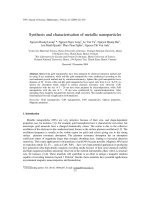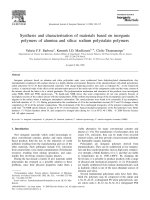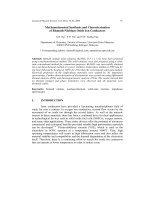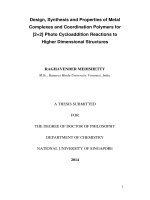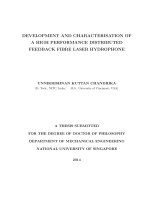Synthesis and characterisation of electrical conducting polymers co polymers based on omega functionalised 3 alkylthiophenes 3
Bạn đang xem bản rút gọn của tài liệu. Xem và tải ngay bản đầy đủ của tài liệu tại đây (775.88 KB, 53 trang )
Chapter 3
Graft copolymers of polythiophene and polystyrene based
on 3
-{ -
[1
-
(p
-
vinylphenyl)]hexyl}thiophene
79
1.
Introduction:
For over two decades, conducting polymers have been hailed as futuristic
material
s. However, the insolubility and infusibility of classical conducting
polymers (polyacetylene, polyaniline, polythiophene, and polypyrrole) make them
difficult to be processed, thus limiting their applications. Combining the classical
conducting polymers with processable insulating compounds has been
demonstrated to be an effective way to improve the processability of polymers
[1
a-d]. Graft co-polymerisation of conducting polymers with commodity
polymers like poly(methyl methacrylate) (PMMA) and polystyrene (PS) as an
alternative
route to improve the physical properties of conducting polymers is
attracting much attention lately. The advantage of this method over the physical
blending
of
conducting polymers and commodity polymers is that long-
term
stability problems are avoided due to the strong chemical bonds formed between
the two different types of polymers [2].
There has been a report on electrochemically grafting polypyrrole on a
polystyrene backbone [3], as well as grafting polyaniline on poly(p
-
aminostyrene)
[4]. Polypyrrole copolymer films can also be prepared electrochemically [5].
Block or graft copolymers of polystyrene and polythiophene or its derivatives
have also been described [6-8]. These materials were formed by direct linkages
between styrene and thiophene moieties.
80
As discussed in the previous chapter, introducing p-vinylphenyl functional groups
to replace -bromo moiety on poly(3- -bromoalkyl)thiophene through
Grignard
reaction was difficult. In a different approach, novel 3-{ -
[1
-(p-
vinylphenyl)]hexyl}thiophene was synthesised. This monomer was polymerised
through a two-step process to yield a graft copolymer. It was also copolymerised
with styrene in different ratios to form a precursor copolymer, which was then
subjected to an oxidative polymerisation step to form a graft copolymer
with
polythiophene backbone. Similar precursor copolymers were either further
copolymerised with thiophene to form new graft copolymers, or copolymerised
with a mixture of 3-alkylthiophene and 3-( -bromoalkyl)thiophene to give
different thiophene
co
styrene graft copolymers. Their structures and properties
were then studied. Some of the properties were compared to the blended poly(3-
octylthiophene) and polystyrene.
81
2.
Experiment:
2.1
Monomer
Synthesis:
The key monomer for this series of graft copolymer, 3-{ -
[1
-(p-
vinylphenyl)]alkyl}thiophene
(3), can be synthesised by either Grignard coupling
of 4-bromostyrene with 3-( -bromohexyl)thiophene or Grignard coupling of 1-
chloromethyl-4-
vinyl
-benzene with 3-( -
bromohexyl)thiophene.
These two
reaction routes were
atte
mpted
. It was found, however, that the yield of the
product obtained from the Grignard coupling using 1-chloromethyl-4-
vinyl
-
benzene was very low. There are two possible reasons. Firstly brominated
compounds are generally more suitable for Grignard reactions, and secondly the
catalyst used for these reactions affects the yield. Ni(dppp)
2
Cl
2
is known to be
more effective when the coupling agents contain
ed
brominated aromatic ring
structure. Therefore, the monomers used in this part of the project were all
af
forded through 4
-
bromostyrene coupling reaction.
The novel monomer 3-{ -
[1
-(p-vinylphenyl)]hexyl}thiophene (3) was formed
through a Grignard reaction (see scheme 3.1) between 4-bromostyrene (2) and 3-
( -bromohexyl)thiophene (1). Sufficient amounts of 3-( -
bromohexyl)thiophene
(1) was prepared following the procedure reported by Bäuerle et al. [9] as
described in the previous chapter.
82
S
C
6
H
12
Br
+
Br
S
C
6
H
12
Ph
1
2
3
2. Ni(dppp)
2
Cl
2
1. Mg/THF
Scheme 3.1
Synthesis of the monomer 3
-{ -
[1
-
(p
-
vinylphenyl)]hexyl}thiophene
83
2.2
Copolymers s
ynthes
e
s:
Through a straightforward two-step polymerisation reaction, monomer
3
can be
converted into a graft copolymer of polystyrene and poly(3-hexylthiophene). In
the first step, AIBN was used as initiator to yield the precursor polymer
3a
. This
polymer was further polymerised by F
eCl
3
following the method reported by Casa
et al. [10] to afford a graft co-polymer with two backbones. Since this copolymer
was made of 100% monomer
3
, it was named
Graft 100
(see scheme 3.2).
S
C
6
H
12
Ph
AIBN
S
C
6
H
12
Ph
n
S
C
6
H
12
Ph
n
m
FeCl
3
3
3
a
G
r
a
f
t
1
0
0
Scheme 3.2
Direct two
-
step polymerisation to afford
copolym
er
Graft 100
It was found that the graft copolymer formed in the way described in Scheme 3.2
was not soluble at all. This is despite its precursor copolymer
3a
being soluble. It
is therefore worthy of investigation to find out if lowering the content of
polythiophene in the system will help produce a more processible copolymer
since polythiophene is known to have lower solubility. One way to achieve this is
to introduce styrene into the copolymer system (Scheme 3.3). When monomer 3
wa
s polymerised together with styrene using AIBN as initiator,
monomer
3 and
styrene will fuse via
a
radical reaction. This reaction produces a copolymer that
contain
ed
more phenyl rings than thiophene rings. Further oxidative
84
polymerisation of this copolymer result
ed
in a copolymer with a longer
polystyrene backbone compared to that of the polythiophene backbone. The
experiments are
illustrated in
Scheme 3.3.
Scheme 3.3
Polymerisation of styrene and monomer in the ratio of 1:1 and 4
:1
afforded
3b
and
3c
respectively, which can be further polymerised
to give
copolymers
Graft 21
and
Graft 51
A series of precursor copolymers,
3b
,
3c
and
3d
(not shown in scheme), were
prepared first
by
co
-
polymerising monomer
3
with styrene in different ratios using
AIBN as initiator. In this ste
p, co
-
polymer
3b
was obtained when the feed ratio of
monomer
3 to styrene is 1:1. While the feed ratio was
1:
4 and 1:10
respectively,
3c
and
3d
was produced. In the next step, when oxidative polymerisation was
carried out using copolymer
3b
, a graft copolymer with a structure that is similar
to that of
3a
was obtained.
Based on the monomer
3 and styrene feed ratio for
3b
,
the theoretical ratio of phenyl rings to thiophene rings in such a copolymer should
C
6
H
12
Ph C
6
H
12
Ph
Ph
n
C
6
H
12
Ph Ph
n
m
AIBN
1xStyrene
FeCl
3
/CH
3
NO
2
3
3b
Graft 21(m:n=1:1)
S S S
C
6
H
12
Ph
Ph
n
S
C
6
H
12
Ph Ph
n
m
FeCl
3
/CH
3
NO
2
Graft 51(m:n=1:4)
S
3c
AIBN
4xStyrene
85
be 2:1. This copolymer was
therefore
named
Graft 21
.
The same rationale is
applied to
3c
. Since
3c
had a monomer to styrene feed ratio of 1:4, the result
ant
copolymer should theoretically contain 5 times more phenyl rings than thiophene
rings. This copolymer was therefore named
Graft 51
.
The actual ratios of phenyl rings to thiophene rings in the copolymers Graft 21
and
Graft 51 will be
slightly
different from that of the expected theoretical
values. The difference can be attributed to the first polymerisation process where
not all styrene c
an
be incorporated into the copolymer system.
Th
ese ‘impurities’
will be in the form
of
styrene
oligomers or polymers that monomer 3
wa
s not
incorporated in. They are carried over to the next step. The
se
compounds
should
not affect the second oxidative polymerisation proc
ess and w
ill
be
discarded
when
the crude grafted copolymers
,
Graft 21
or
Graft 51
,
are
subjected to soxhlet
extraction using methanol and acetone in turn.
Despite the lowered percentage molecular weight of the thiophene unit in the two
graft copolymers
Gr
aft 21
and
Graft 51, these two polymers were
still
found to
be insoluble. One possible reason for this could be the
possible
presence of
rigid
cross
-linked structures of the three grafted copolymers: Graft 100, Graft 21 and
Graft 51. This will be discussed
in further
detail
in the later parts of this chapter.
In order to obtain a more processible polymer, 3-alkylthiophene or its derivatives
will be introduced into the copolymer system to impart a less rigid structure and
to promote solvent-polymer interacti
on
. The graft copolymer formed in such a
86
way will have two polymer backbones: the polystyrene backbone and the
polythiophene backbone. U
nlike
Graft 100
,
Graft
21
or Graft 51, not all
thiophene rings are linked to the polystyrene backbones in the newly form
ed graft
copolymers. This will give the polythiophene backbones more freedom of
movement and hence introduce different physical & chemical properties to these
copolymers. As such, experiments were carried out to form graft copolymers
consisting two backbones but linked only at certain points. The idea is illustrated
below:
These copolymers should have about equal amounts of thiophene and styrene in
order for a comparison to be carried out with
Graft 100
. In the first step of a two
-
step synthesis (see Scheme 3.4), the monomer 3 to styrene ratio
was
fixed at 1:10
to form copolymer
3d
. In the second step, copolymer
3d
will be mixed with 3-
alkylthiophene or its derivatives in a 1:10 mole ratio. The resultant graft
copolymer would therefore, have about equal amounts of styrene and
percentage
molecular weight of the thiophene unit. The ratio of 1:10 was used in the hope of
giving the polymer backbone enough space for movement (especially for
polythiophene backbones). Ideally, on the polythiophene backbone in the graft
copolymer, there should be
about
ten thiophene rings that are
not
linked with the
PS PS PS PS
PS PS
TH TH TH TH TH TH
PS PS PS PS PS PS
TH TH TH TH TH TH
87
polystyrene backbone alternating
between
two thiophene rings that
are
linked
with
the
polystyrene backbone via alkyl chain linkages
to facilitate movement
.
In the
experiment
, copolymer
3d
was mixed in a 1:5 mole ratio with 3-( -
bromohexyl)thiophene and in a 1:5 mole ratio with 3-octylthiophene before
oxidative copolymerisation was carried out for the mixture. The result
ant
graft
copolymer
4, therefore, should theoretically have about equal numbers of phenyl
rings and thiophene rings. 3-( -bromohexyl)thiophene was introduced to show if
radical polymerisation step using AIBN as initiator affected the thiophene group.
The results will be discussed later in this chapter
.
Graft co-
polymer
5 was
produced based on precursor co-
polymer
3d
. Polymerisation of a mixture of
3d
and thiophene in 1:10 mole ratio using Casa’s method [10] produced
5
(see
scheme 3.4).
As comparison, a polymer blend of polystyrene and poly(3-
octylthi
ophene) was
also prepared. Polystyrene was formed by polymerising styrene in a 1:1 styrene
and 3-octylthiophene mixture using AIBN as initiator. Subsequently, CH
3
NO
2
solution of FeCl
3
was added in situ to polymerise 3
-
octylthiophene.
88
Scheme 3.4
Polymeri
sation of styrene and monomer 3 in the ratio of 10:1
produced
3d
, which can be further co-polymerised with 3-
octylthiophene and thiophene
C
6
H
12
Ph C
6
H
12
Ph Ph
AIBN
C
6
H
12
Ph Ph
C
8
H
17
C
6
H
12
Ph Ph
FeCl
3
FeCl
3
S
S
S
S
S
(CH
2
)
6
Br
S
S
n
Styrene
3 3d
n
m
n
m
4
5
3-octylthiophene/
3-(w-bromohexyl)thiophene
thiophene
x
89
3.
Results and Discussion:
3.1
Monomer
synthesis and c
haracterisation of
The novel monomer
3
was characterised by
1
H,
13
C NMR and elemental analysis.
The NMR spectra confirmed the structure of the monomer.
3.1.1
NMR
The
1
H NMR is shown in Fig. 3.1.
The multiplets between 1.30-1.65 ppm are a result of hydrogen resonance of
methylene protons on the alkyl chain that is not adjacent to the aromatic rings.
The quartet at 2.65 ppm is due to the overlapping of two methylene groups that
are immediately neighbouring the thiophene and benzene rings. The chemical
environment of the two methylene groups is similar which resulted in the peaks
appearing at the same chemical shift. The peaks appearing at 5.22 and 5.73 ppm
should be viewed as a doublet of doublets. Together with another doublet of
doublets at 6.73 ppm, they account for the coupling of the alkene protons. The cis
and trans
hydrogen on the terminal alkene carbon split the signal caused by proton
atom that is adjacent to the benzene ring. Apart from coupling with the other
allylic proton, the cis and trans proton atoms also have strong geminal coupling,
giving rise to doublet
s at 5.22 and 5.73 ppm.
Fig 3.2 shows the
13
C NMR spectrum of the monomer.
90
Fig 3.1
1
H NMR spectrum of monomer 3
Fig 3.2
13
C NMR spectrum of monomer
3
S
C
6
H
12
Ph
3
S
C
6
H
12
Ph
3
91
T
he peaks at 136.7 ppm and 136.6 ppm
in
13
C NMR
were caused by C at phenyl 1
position and thiop
hene 3 position respectively. The double bond C that was closer
to the phenyl ring produced a peak at 135.0 ppm. The peak at 131.3 ppm was
caused by the C at p position on the phenyl ring, whereas the deshielded C at
position 4 of the thiophene ring gave rise to the peak at 130.2 ppm. The peaks at
around 128 ppm were
attributed
to the o position carbon on the phenyl ring and
peaks at 126 ppm can be ascribed to C on position 5 of the thiophene ring. Carbon
on
m position of the phenyl ring should account for the peak at 125.0 ppm, while
C on position 2 of the thiophene ring resulted in a peak at 119.7 ppm. The double
bond
ed
C that was further from the phenyl ring
produc
ed peaks around 113
ppm.
The peaks in the region of 29.0 ppm to 37.3 ppm were due to the carbons on the
alkyl long chain, with Cs closer to the aromatic ring having higher chemical
shifts.
The NMR spectra
also
indicate that the monomer was not
quite
pure. In
1
H NMR,
the singlet at 2.9 ppm and some small peaks in the aromatic region could not be
accounted for. In the meantime, chemical shifts seen at ~141 ppm in
13
C NMR
were not likely to be caused by
the
carbon on the monomer. One possible source
of impurity could be the stabiliser, 4-
tert
-butylcatechol, used in the starting
material,
i.e.
4-
brom
ostyrene.
Attempts were made to wash off the stabiliser with
NaOH. However, this results in the Grignard reaction producing monomer with
compromised yield. On the other hand, when washing was omitted, substantial
amount
s of monomers were obtained from the same reaction. The only drawback
92
of the latter method is the production of an impurity that cannot be removed
despite repeated column chromatography.
D
istillation under reduced pressure was
not carried out to avoid loss of monomer as a result of premature
polymerisation.
Another likely source of impurities could be oligomers with very few repeating
units.
In spite of
the presence
of impurities, the integration ratio of double bonded
Hs (the doublet of doublet at ~6.72 ppm and ~5.47 ppm) and methylene Hs nex
t
to the aromatic rings (multiplets at ~2.64 ppm) on
1
H NMR was 3:4. This is
in
agreement with the theoretical value
, i
ndicat
ing
tha
t the impurities
did not contain
any vinyl phenyl group and hence should not interfere with the polymerisation of
the monomer. Therefore the polymerisation step was carried out using this
product.
93
3.
2
Copolymers
characterisation
3.2.1
Physical Properties
All the intermediate co-
polymers,
3a
,
3b
,
3c
and
3d
, were white powders that
were soluble in common polar solvents such as chloroform and THF, similar to
polystyrene. However, upon the second polymerisation process, the morphology
of the grafted co-polymer changed drastically.
Copolymer
Graft 51 was a yellow
powder.
Copolymers
Graft 21 and Graft 100 were orange-coloured powders
.
These three co-polymers were found to be insoluble. Copolymer 4 was a dark
brown powder. Copolymer 5 was a red powder. About 10% of
copolymer
5 can
be soxhlet-extracted by CHCl
3
whilst about 20-30% of
4
can be extracted. The
soluble parts of these two polymers were subjected to further interpretation by
NMR, GPC, UV
-
Vis etc. Finally the co
-
polymer blend of polystyrene and poly(3
-
octylthiophene) was in the form of black powder and was soluble in common
polar solvents.
94
3.
2.2
NMR
The NMR spectrum of
3a
is shown below. The broad band at ~6.9 ppm and ~6.5
ppm
suggests
that polymerisation of styrene had occurred. Sharp peaks at ~7.25
ppm and ~6.9 ppm were caused by aromatic hydrogen resonance on thiophene
rings. Traces of the monomer are evidenced by the small peaks at ~5.7 ppm and
~5.2
ppm. Polymerisation of p- substituted vinyl phenyl groups induced two
broad peaks in the lower field. One weaker
broad
peak at ~2.8
ppm
represent
s
methine (
-
CH) hydrogen on the alkyl backbone of the polystyrene chain, the other
stronger
broad band at ~2.5
ppm
is attributed to methylene groups neighbouring
the phenyl rings. The peaks caused by –
CH
2
next to the thiophene rings at ~2.6
ppm
overlapped these two peaks
slightly.
Fig. 3.3
NMR of precursor polymer
3a
S
C
6
H
1
2
P
h
n
3
a
95
NMR spectra of 3b, 3c
and
3d
showed similar features except that the peaks
caused by the polystyrene backbone are stronger due to co-polymerisation with
styrene. An example spectrum of
3c
is shown in Fig 3.4.
Fig. 3.4
NMR spectrum of precursor copolymer
3c
While studying the NMR spectra of these precursor copolymers, one of the
complications
encountered
is that if some of the thiophene moiety in the monomer
was polymerised at this stage, they would have produced peaks at ~2.8 ppm and
~2.5
ppm too, depending on the way the thiophene rings were connected. It is
therefore difficult to exclude the possibility of the thiophene polymerising based
on the NMR spectrum alone. In order to study if the thiophene moiety
had
C
6
H
12
Ph
Ph
n
S
3
c
96
polymerised
, 3-( -bromohexyl)thiophene was added together with monomer 3
and styrene in 5:1:10 mole ratio. After radical polymerisation,
the
reaction
mixture
wa
s
extracted and washed. Its NMR spectrum is
shown below:
Fig. 3.5
NMR spectrum of the resulted copolymer from 3-( -
bromohexyl)thiophene, monomer
3
a
nd styrene in 1:1:10 mole ratio
The sharp and obvious triplet that was caused by –
CH
2
Br hydrogen resonance
clearly indicated that polymerisation of 3-( -bromohexyl)thiophene did not
occur.
Hence, we can conclude that thiophene rings did not polymerise und
er
these experimental conditions. This is further supported by the presence of the
peaks at ~7.25 ppm and 6.9 ppm.
Consequently,
a graft copolymer system
containing two different polymer backbones that are connected through an alkyl
97
chain linkage was formed through the second oxidative polymerisation of the
copolymers.
The abovementioned precursor copolymer mixture was further oxidised with 3-
octylthiophene to give graft copolymer
4.
The NMR spectra of the
polymer
blend
and
4 are depicted in Fig. 3.6
and F
ig. 3.
7
respectively
.
Fig. 3.6
1
H NMR spectrum of the polymer blend of PS and poly(3-
octylthiophene)
The two spectra have some similar features
:
98
i)
the multiplets between 6.9 to 7.2 ppm were caused by aromatic Hs at
positions
o and p on the phenyl rings, as well as protons at positions 4 on
the thiophene rings of the polymer.
ii)
The multiplets between 6.5 to 6.6 ppm account for the protons at position
m
on the phenyl ring.
Fig. 3.7
1
H NMR spectrum of grafted copolymer
4
The two broad bands at ~2.5 ppm and ~2.8 ppm on the spectra of the blended
copolymer and grafted copolymer 4
do
not represent the same functional group.
In the
polymer
blend these two peaks are ascribable to –
CH
2
protons on the alkyl
side chain immediately adjacent to the thienylene rings. When the 3-
C
6
H
12
Ph Ph
n
C
8
H
17
m
4
S
S
S
(CH
2
)
6
Br
x
99
alkylthiophenes are joined in head to head (HH) fashion this peak appears at 2.55
ppm
. If they
were
joined in head to tail (HT) fashion, the peak
would
appear
at
2.80 ppm [12]. In copolymer 4, the peaks caused by the –
CH
2
and –CH groups
neig
hbouring
the
phenyl rings coincide with peaks due to methylene groups next
to the thiophene rings at 2.5 and 2.8 ppm, as discussed above. The major
difference between the two spectra is the broad peak at ~3.5 ppm on
4
, which was
caused by
–
CH
2
Br.
It has to be noted that the NMR spectra of grafted copolymers may give
qualitative structural information of the polymer,
e.g.,
type of bonding and
functional groups. The integration of the peaks, on the other hand, might not have
provided the correct information on the chemical composition of each functional
group in the bulk of the copolymer. This is due to the fact that a major portion of
the copolymer was not soluble for NMR analysis.
In the case of 5, weak broad bands were detected between 2.5 and 2.8 ppm. T
he
shape of the bands resembles its precursor copolymers. Peaks at 2.5 and 2.8 ppm
are the result of –
CH
2
protons on the alkyl side chain adjoining the phenyl rings
and the –CH group at p position of this methylene group, as
was
discussed. Since
copolymer
5 was formed by polymerising
3d
and thiophene in 1:10 ratio, we can
expect that
most
of the
mono
-substituted thienylene rings originating from
monomer
3 to be
linked
with thiophene (added during the second polymerisation
step).
This would give rise to tri-substituted thienylene rings in the graft
100
copolymer.
The methylene groups on the alkyl chain that is neighbouring these
tri
-substituted thiophene rings have similar chemical environment and give a
single broad peak at 2.6 ppm. The low intensity of the band is due to the fact that
the alkyl side chain content is relatively low in this copolymer.
Fig. 3.8
1
H NMR spectrum of grafted copolymer of PS and polythiophene
(5)
Ph
n
m
5
S
S
CH
2
(CH
2
)
4
CH
2
Ph
c
b
a
101
3.2.3
FT-
IR
Fig. 3.
9
is
the IR spectra of
graft copolymer
s 4
,
5
and the blended copolymer.
Fig. 3.9
IR spectra of copolymers
4
,
5
and the copolymer blend
The spectra of the
other
six copolymers were quite similar due to their similar
structure
s. The bands between 3100-3000 cm
-1
are due to aromatic C-H stretch
present in all three polymers. The band at around 2922 cm
-1
is a result of
asymmetric
–
CH
2
stretch and the band at 2849 cm
-1
is ascribable to symmetric –
CH
2
stretch. A series of weak bands between 2000-
1650
cm
-
1
observed
are the
overtone
s or combination region that is characteristic of phenyl ring containing
compounds. Aromatic ring C-C stretching bands give rise to the bands at around
1600, 1495 and 1450 cm
-1
. The bands at 1070 and 1025 cm
-1
are caused by in
plane C-H bending. The band at around 750 cm
-1
is due to out of plane aromatic
r
ing C
-
H bend.
102
The most noteworthy difference between the IR spectra of copolymer
Graft
100
(see Fig. 3.10) and the
other
copolymers is the absence of the peak at 700 cm
-1
,
which is a result of mono substituted aromatic ring bands [13].
Graft
100
is
forme
d exclusively by the monomer 3-{ -
[1
-(p-
vinylphenyl)]hexyl}thiophene,
hence there is no mono substituted phenyl ring in its structure. All phenyl groups
were di-substituted therefore unlike all other copolymers, the peak at 700 cm
-
1
is
absent on the spectrum of
copolymer
Graft
100
.
On the spectrum of
copolymer
5, a very weak peak appeared at around 825 cm
-1
whereas on all other spectra, this peak is quite obvious. The band is caused by C-
H out of plane bending of 2,3,5-trisubstituted rings [13] of the polymerised 3-
alkylthiophene
s. These tri-substituted polythiophene rings are abundant in all the
copolymers except
copolymer
5. This copolymer mainly consists of di-
substituted
polythiophene rings. Hence in
the
spectrum
of
copolymer
5, only a weak peak
appear
ed in this region, which is caused by its precursor copolymer, i.e.
copolymer
3d
.
